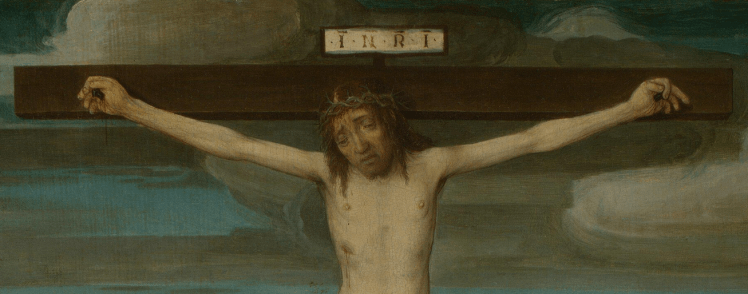You may be thinking, ‘We are there too soon,’ but part of the function of Lent is the preparation for the inevitable. It is a period of self-denial, of prayer and of repentance, but we have all given up so much over the last year, we are all living within such restricted circles, that I am not convinced that we need to do any more. But for Christians this is a time in which prayer and contemplation is specifically about Christ’s sacrifice, so the Crucifixion would be remembered daily. It could even be considered odd that this is the first time we have seen the crucified Christ, given that we have already arrived at day 34 of my Lenten discipline. As I’m sure you know, there are forty days in Lent, reflecting Jesus’s forty days in the wilderness, and just in case you were wondering, given that we are at day 34, how this could possibly last until Easter – which is just under two weeks away – I should point out that the forty days of Lent last for 46 days. But I will explain that in detail next week!

Jesus is crucified as we would expect – and as we have learnt to expect from all the images we have seen of him in the past. A nail has been driven through the palm of each hand, and, however physiologically impossible that would be, it was the tradition and not to be altered. There is no sense of the weight of the body, the pull on the arms which could dislocate the shoulders, the lifting of the rib-cage which eventually causes suffocation. You could argue that there is nothing too unbearable to look on, or we would avoid it altogether – but there are other traditions that do not shy away from the anguish, from the extreme suffering, or from the grotesque, even. You could equally argue that this portrayal is a sign of Christ’s inevitable triumph over his suffering, and then, over death. We see now, given that it was not clear in Lent 32, that his chest has already been wounded, as described in John 19:33-34,
But when they came to Jesus, and saw that he was dead already, they brake not his legs: But one of the soldiers with a spear pierced his side, and forthwith came there out blood and water.
Whatever the physiological explanation for this phenomenon might be, the blood is, of course, the blood shed for us, which is commemorated during the celebration of the Mass, as instituted at the Last Supper, whereas the water can be seen as the water of life, the promise of life everlasting, as mentioned, for example, in the Book of Revelation 21:6,
And he said unto me, It is done. I am Alpha and Omega, the beginning and the end. I will give unto him that is athirst of the fountain of the water of life freely.
However, the painting contradicts the verses from John. They say that his chest was not pierced until after he had died – and yet he appears to be still alive, and suffering, in this painting. But think back to all of the images of the Crucifixion you have seen: they always include the wound to the chest, whether Christ is alive or dead. That is because, on the whole, images of the Crucifixion are not illustrations of a specific point of the narrative, but the result of a long evolution which means that they can encompass the entire story – the entirety of Christ’s suffering.

An essential part of this passion – which means ‘suffering’ – is the crown of thorns, originally thrust onto his head when he was mocked as ‘King’, as described in John 19:2-3,
And the soldiers platted a crown of thorns, and put it on his head, and they put on him a purple robe, And said, Hail, King of the Jews! and they smote him with their hands.
This was mockery which aimed to hurt both mentally and physically, but although the purple robe was removed, the crown remained. We saw it atop the Scala Santa (Lent 15) and on the Via Crucis (Lent 22). Now, still wearing the crown, and underneath the sign saying ‘Jesus of Nazareth the King of the Jews,’ it confirms his kingship, and his reign over suffering, and over death. Around his head the clouds gather (Matthew 27:45):
Now from the sixth hour there was darkness over all the land unto the ninth hour.


You mentioned once, in a lecture I heard, which Bible version you use and I can’t recall. Would you mind telling me? I’m just curious because I have studied a bit of Theology and scripture in my past. You have an amazing scriptural background which really enhances the art history and gives great context! Thoroughly enjoy your teaching! Just left the Michelangelo Zoom (part 1) and, again, using scripture to help understand the painting or sculpture is so helpful e.g., the lion near David the shepherd, pure and post Goliath, etc. Love it!!
LikeLiked by 1 person
Thank you, Bernie, I am so glad you are enjoying it. I always quote from the King James Version of 1611. There are more recent translations, and more accurate translations, I’m sure, I just love the language.
LikeLike
Thank you so much Richard : you really are making it possible for us able to walk the Way of the Cross and the Crucifixion.
Meanwhile, you are quite right : that that is enough for the present time in view of what has been given up and lost through the pandemic.
With the texts of St James version and your insight into the art of the chosen picture you are making this ‘via crucis’
very special : thank you again. Julia
LikeLiked by 1 person
A pleasure Julia, thank you!
LikeLike
Grat sentiments…good thoughts.
Thanks
LikeLiked by 1 person